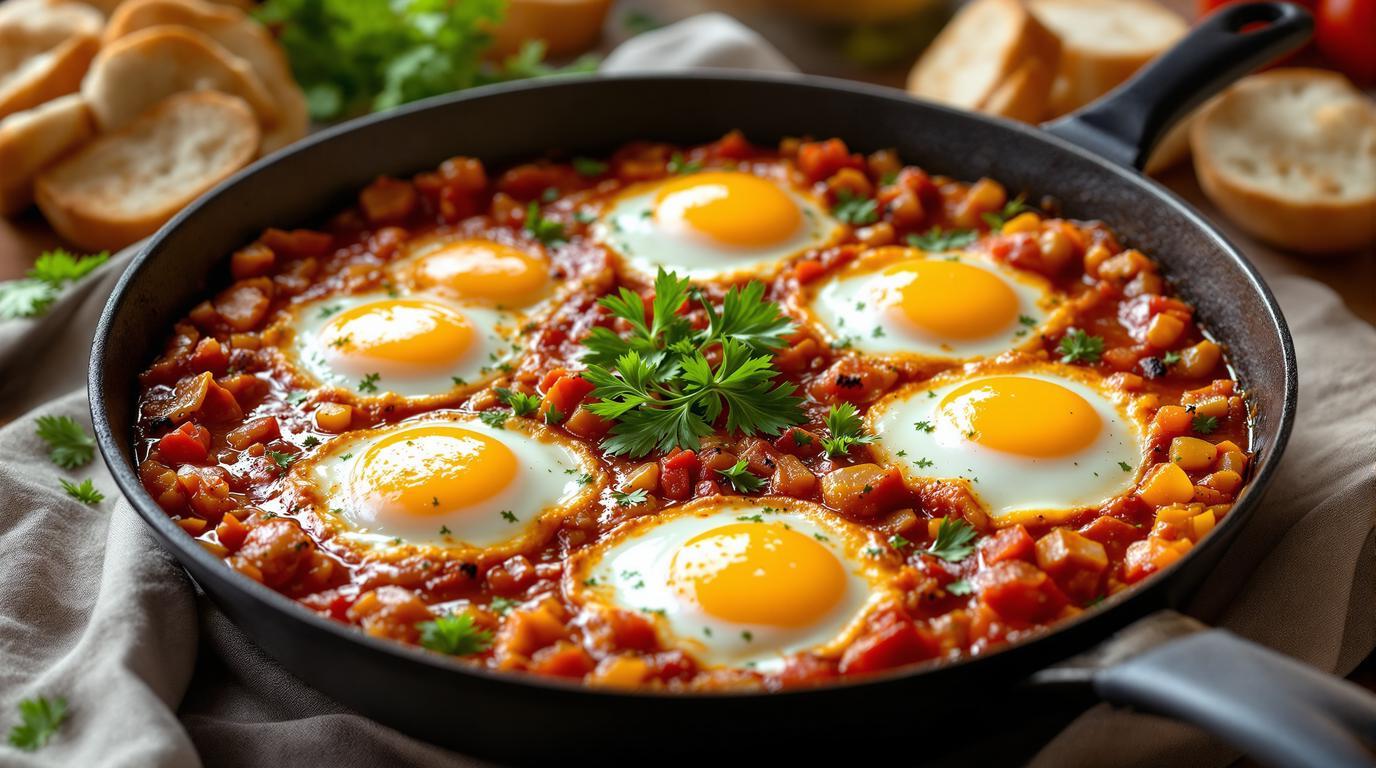There’s something almost magical about shakshuka that transcends its humble ingredients. Growing up, my grandmother would prepare this dish whenever the tomatoes in her garden reached peak ripeness. The memory of that fragrant, bubbling pan still transports me back to her sun-drenched kitchen in an instant. While shakshuka has North African origins—specifically Tunisia—it’s become beloved across the Middle East and Mediterranean. What makes this one-pan wonder so special isn’t just its simplicity, but how it transforms basic ingredients into something extraordinary through patient cooking and thoughtful spicing. The real secret? Those perfectly runny egg yolks that create their own sauce when punctured with a piece of crusty bread. 🍳
The Story Behind Traditional Shakshuka 📖
Shakshuka (meaning “a mixture” in Tunisian Arabic) originated as a farmer’s breakfast in North Africa, utilizing fresh vegetables and eggs—ingredients that were readily available. The dish traveled through Ottoman trade routes, evolving with regional variations along the way. What began as a practical meal has become a symbol of communal dining, traditionally served directly from the cooking vessel for everyone to share. In my professional kitchens, I’ve prepared countless variations, but I always return to this grandmother-style recipe that honors the dish’s rustic roots. 🌍
Essential Ingredients 🧾
For authentic shakshuka (serves 4-6), you’ll need:
- 3 Tbsp (45ml) extra-virgin olive oil
- 1 large yellow onion, diced (about 2 cups/300g)
- 2 bell peppers (preferably 1 green, 1 red), diced (about 2 cups/300g)
- 3 garlic cloves, minced (about 1 Tbsp/10g)
- 1 tsp ground coriander
- 1 tsp sweet paprika (or smoked for deeper flavor)
- 1 tsp ground cumin
- ¼ tsp chili flakes (adjust to taste)
- 4 cups (800g) chopped fresh tomatoes OR 1 (28-oz/800g) can whole/crushed tomatoes
- ¼ cup (60g) tomato paste
- 6 large eggs
- Salt and freshly ground black pepper
- Fresh parsley and/or mint for garnish
Step-by-Step Instructions 📝
1. Build Your Flavor Base: Heat olive oil in a large, deep skillet (10-12 inches) over medium heat until shimmering. Add onions and bell peppers with a pinch of salt. Cook for 5-7 minutes, stirring just occasionally to allow some caramelization and charring—this is where the magic begins! 🔥
2. Bloom Your Spices: Once vegetables have softened and begun to brown, add garlic, coriander, paprika, cumin, and chili flakes. Stir constantly for 60 seconds until intensely fragrant. This brief toasting releases the essential oils in your spices—a technique I learned working in a Moroccan kitchen years ago. ✨
3. Develop Your Sauce: Add tomatoes and tomato paste, stirring to incorporate. Bring to a gentle simmer, then reduce heat to medium-low. Allow the sauce to cook uncovered for 15-20 minutes, stirring occasionally, until it thickens considerably. Season with salt and pepper to taste. 🍅
Chef’s Note: The key to exceptional shakshuka is patience during this sauce-building phase. A properly reduced tomato base should hold its shape when you make wells for the eggs. If using fresh tomatoes in summer (as my grandmother did), extend the simmering time by 5-10 minutes to allow excess moisture to evaporate.
4. Create Your Egg Nests: Using the back of a spoon, make six evenly spaced wells in your sauce. Crack an egg into each depression. Season each egg with a tiny pinch of salt and pepper. 🥚
5. Cook The Eggs: Cover the pan and simmer on low heat for 5-8 minutes until egg whites are set but yolks remain runny. For more even cooking, you can finish in a preheated 350°F (175°C) oven for 8-12 minutes instead. 👨🍳
Chef’s Secret Techniques 🤫
The difference between good and exceptional shakshuka lies in understanding these culinary nuances:
- Char Don’t Steam: Resist the urge to stir vegetables constantly—allowing them to develop brown edges builds incredible depth.
- Tomato Paste First: Cook your tomato paste for 60 seconds before adding fresh/canned tomatoes to caramelize its sugars and remove any tinny flavor.
- Balance Acidity: If your tomatoes are particularly tart, add ½ teaspoon of sugar or a splash of balsamic vinegar to round out the flavor.
- Low and Slow Eggs: Keep the heat gentle when cooking eggs—aggressive simmering leads to rubbery whites and chalky yolks.
Serving & Presentation Tips 🍽️
Serve shakshuka directly from the cooking vessel while still bubbling hot. Garnish generously with fresh herbs and, if desired, crumbled feta cheese. The traditional accompaniment is warm, crusty bread—perfect for scooping up sauce and dragging through those luscious egg yolks. This pairs beautifully with a simple Israeli salad or, for a fancier brunch, a glass of crisp Sauvignon Blanc or dry Prosecco. 🥂
Whenever I prepare this dish, I’m reminded that cooking isn’t just about feeding people—it’s about connection. There’s something profoundly satisfying about watching friends and family gathered around a single pan, tearing bread and dipping into this vibrant, communal creation. Whether you’re making this for a lazy weekend breakfast or a quick weeknight dinner, I hope this shakshuka brings the same warmth and joy to your table that it has to mine for decades. Remember, the best shakshuka isn’t the most perfect—it’s the one shared with those you love. Enjoy! 💕
